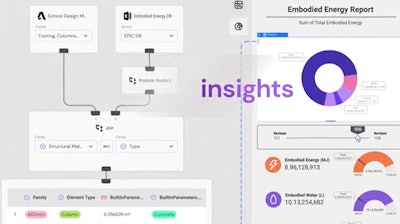
Some good news for the construction industry is rapid adoption of cloud-based and software-as-a-service (SaaS) software for finance, operation and document sharing is finally bringing contractors' data into predictable data structures.
Some bad news is that in an industry that requires extensive collaboration across organizational boundaries among general contractors, subcontractors and owners, it can still be next to impossible for generals and owners to get reliable, real-time visibility into progress against project deliverables. Modern SaaS software built on a service-oriented architecture may be able to open up windows into progress by exposing bits of data at precise points in a process as a web service, but the disparate data structures that underpin these systems still resist an organized approach to business intelligence or analytics.
That is the problem being addressed by Toric, a San Francisco-based startup co-founded in 2019 by CEO Thiago Da Costa. Da Costa earlier had founded 3D CAD design and photo-real visualization technology pioneer Lagoa, which he sold to Autodesk in 2014. His current venture offers a low-code, no-code platform that enables contractors, architects, engineering firms and project owners to consolidate data from multiple platforms used across the ecosystem of companies engaged in producing the value of construction in the field.
Toric on January 26 announced a $5.5 million stealth seed round in late 2019 led by Storm Ventures with key participation from angel investor and former Autodesk CEO, Carl Bass, who joined Toric’s board of directors. They also announced a $10.5 million October of 2021 Series A round led by Leaders Fund with angel investors Chris Lynch, chairman of DataRobot and CEO of AtScale, along with Plangrid co-founder, Ralph Gootee. The additional funds have enabled Toric to execute its go-to-market strategy while increasing the number of data integrations, partnerships and platform features.
“Companies that lack insights into their operations and costs are losing money that could be invested in future growth,” former Autodesk CEO Bass said. “Thiago knows how to identify underserved markets and provide them with a commercial solution that helps solve their biggest pain points. I was immediately onboard with the Toric concept, and the market validation has been fantastic.”
A Beachhead in the Market
The company is also making inroads in selling to major contractors and project owner organizations, with most deals coming among members of the ENR Top 400 General Contractors. Various parties have already bought into the platform, and the challenge according to Da Costa is to take the same set of data and make it meet the varying needs of all parties.
“Most of our wins are with general contractors, and we are seeing some wins with owners,” Da Costa said in a phone interview the day of the announcement with ForConstructionPros. “I think the beautiful thing about the construction space is the data is the same for everyone, but the needs are different from each party. Everybody needs the design to be complete so they can do their work. Everybody needs the engineering to be complete so they can move the project forward. But for a general contractor, even though the data is the same, the needs are different. An owner wants more transparency. We have a couple owners in the platform—I can’t disclose their names. They want more transparency into what is going on with the contractors. Have they advanced the design? Does it meet their requirements—does it meet the specification? Owners have that interest.
 Owners can use Toric and other data aggregation/construction analytics platforms coming to market to track progress across distributed project teams.
Owners can use Toric and other data aggregation/construction analytics platforms coming to market to track progress across distributed project teams.
"General contractors meanwhile get design data last minute and they have to bid on it. They don’t know what’s in there. So it gets back to the data again."
Architects meanwhile are experiencing labor shortages, and thin staffing may lead to mistakes the general needs to catch before bidding and before the project goes into production.
Even after project completion, owners and operators want to use the same data set used for design and construction to inform maintenance and operation, as called for by the ISO/AWI 5000 asset management standard. These insights can flow multiple ways—from construction into operations to inform maintenance decisions, from maintenance up to management as component changes flow into an as-maintained asset model and from a future state into construction to enable engineers and architects to design for the asset lifecycle.
“We have had people who want to know what is the cost of maintaining this retaining wall over its lifecycle,” Da Costa said. “What is the cost of replacing all of my mechanical equipment over a certain time window.”
Current and Planned Functionality
Toric offers its customers a low-code, no-code platform that enables them to connect these disparate data sources into visually comprehensible analytical models.
One of the primary use cases for contractors, Da Costa said in a phone interview with ForConstructionPros, is to access historical project data to support bidding and estimating. The application would rely on historical project data and compare it to requirements in a project being bid. What is not in the current iteration of the product is predictive analytics—an attractive feature in inflationary times.
“This is something customers are asking—when we can provide standard metrics on the cost of steel, aluminum, glass and other commodities,” Da Costa said. “That is something we will integrate in the platform in the future. We don’t provide that today. We take the data you have today and use that as indicative of how you perform in the next job. So you can see the number of square feet of a past project, whether you made or lost money. And based on the location, the same building in Houston or San Francisco will have different cost structures.”
Predictive capabilities are on the roadmap according to Da Costa, starting with a machine learning capability that will in turn underpin predictive analytics.
“We are introducing a machine learning module first in the second part of the year,” Da Costa said. “This will drive capabilities for augmenting data in the platform—detecting the relationship of a data point with other data points—predictive would come on top of that, so probably end of the year or early next year.”
Use cases for the machine learning capability would include the ability to ingest data on multiple projects of a similar type—data centers for instance—identify the overlapping qualities between them and use the resulting insights to set up constrains and parameters for how that class of projects should be estimated, managed, operated or maintained.
Toric also offers the ability to port consolidated and cleaned data into an S3 data lake storage platform on Amazon Web Services, to a customer’s data warehouse or a data lake inside of Toric.
Implications for Smaller Contractors
Contractors and project owners adopting the Toric platform are among the largest in the world, but the advent and proliferation of applications that consolidate, clean and perform analysis on data from multiple construction trading partners will have implications for those performing work for these large generals and owners.
In an industry that has been slow to adopt enterprise software, it is imperative that smaller contractors begin to keep their business, project and asset data in applications with a consistent, predictable data structure.
“You should use a construction management tool like Procore,” Da Costa said, adding that the company on the day of the interview announced a partnership with the leading construction software vendor. “A subcontractor will open their instance of Procore to the general or the owner and Toric does analytics on that data.”
Procore is broadly used, but the goal of Toric and other companies intent on solving construction’s data visibility problem is to cut across platforms as no single vendor will own the market.
“We partner with everyone—all of these companies have so many vendors,” Da Costa said. “The data is fragmented. Nobody is going to just adopt one tool—there is a competitor for Procore around the corner. Contractors should just se the best tool for the job. We are the glue to connect all of these data sets together. We integrate with 20-plus solutions—AutoDesk, Procore, safety data—we take enterprise resource planning (ERP) data, we take Oracle Primavera—we are integrating those solutions as well.”
While Da Costa said Toric has sourced information from Excel spreadsheets, the spreadsheets themselves must be formatted consistently so data structures and conventions are the same across projects. In many contracting organizations, each project manager may have their own unique approach to managing or tracking projects in Excel. The growth in Toric and tools like it mean now is the time for contractors to get serious about standardizing data.
“If you are operating like that you are probably going to be losing,” Da Costa said. “The people performing in this space are incredibly organized now. They are really paying attention to how they do their bids and their processes, they are performing training internally. They are really focused on this because they know that is where they are getting their competitive advantage.”
BOTTOM LINE: Technology that provides visibility across the multiple software applications and organizations involved in delivering construction projects is making progress, and Toric is a prime example. While these applications are coming first to large contractors, smaller contractors and subs need to get serious about having a consistent data strategy so they can reliably deliver not just work in the field but accessible, reliable and consistently structured data from their back offices.



















